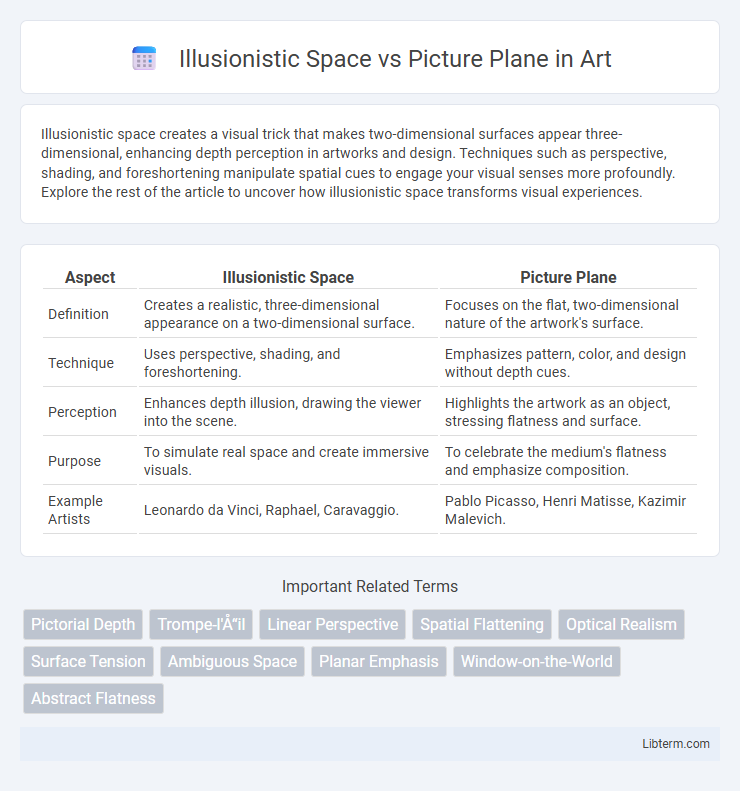Illusionistic space creates a visual trick that makes two-dimensional surfaces appear three-dimensional, enhancing depth perception in artworks and design. Techniques such as perspective, shading, and foreshortening manipulate spatial cues to engage your visual senses more profoundly. Explore the rest of the article to uncover how illusionistic space transforms visual experiences.
Table of Comparison
| Aspect | Illusionistic Space | Picture Plane |
|---|---|---|
| Definition | Creates a realistic, three-dimensional appearance on a two-dimensional surface. | Focuses on the flat, two-dimensional nature of the artwork's surface. |
| Technique | Uses perspective, shading, and foreshortening. | Emphasizes pattern, color, and design without depth cues. |
| Perception | Enhances depth illusion, drawing the viewer into the scene. | Highlights the artwork as an object, stressing flatness and surface. |
| Purpose | To simulate real space and create immersive visuals. | To celebrate the medium's flatness and emphasize composition. |
| Example Artists | Leonardo da Vinci, Raphael, Caravaggio. | Pablo Picasso, Henri Matisse, Kazimir Malevich. |
Defining Illusionistic Space in Art
Illusionistic space in art refers to the technique of creating the visual perception of depth and three-dimensionality on a two-dimensional surface, often achieved through methods like linear perspective, shading, and foreshortening. This approach manipulates spatial cues to trick the eye into experiencing a realistic scene that appears to extend beyond the picture plane, transforming flat artworks into immersive environments. Defining illusionistic space involves recognizing its role in bridging the gap between the physical picture plane and the imaginary spatial environment depicted within the artwork.
Understanding the Picture Plane
Understanding the picture plane is essential in distinguishing illusionistic space from flat surface perception in art. The picture plane serves as the two-dimensional boundary where artists manipulate elements like line, color, and perspective to create the illusion of three-dimensional space. Mastery of the picture plane allows the viewer to perceive depth while recognizing the underlying flatness of the canvas.
Historical Evolution of Pictorial Space
The historical evolution of pictorial space reveals a shift from the flat, two-dimensional picture plane of medieval art to the sophisticated illusionistic space developed during the Renaissance, marked by the introduction of linear perspective by Filippo Brunelleschi. This development allowed artists to create a convincing three-dimensional depth on a flat surface, transforming the viewer's spatial experience within paintings. Later movements challenged and redefined illusionistic space, but the breakthrough in recreating depth on the picture plane fundamentally changed Western art's approach to representation.
Key Techniques Creating Illusionistic Depth
Key techniques for creating illusionistic depth include linear perspective, where parallel lines converge at a vanishing point to simulate three-dimensional space, and atmospheric perspective, which uses color and clarity to suggest distance by fading tones and reducing detail. Chiaroscuro applies contrasting light and shadow to model forms and enhance volume, while overlapping objects establish spatial hierarchy and depth relationships. These methods manipulate visual cues on the picture plane to convincingly render a believable illusion of space.
Flatness and the Assertion of the Picture Plane
Illusionistic space creates the perception of depth by employing techniques like perspective and shading, contrasting sharply with the flatness emphasized in the assertion of the picture plane. Artists such as Kazimir Malevich and Piet Mondrian championed flatness to reject traditional illusionism, highlighting the two-dimensional surface as a fundamental aspect of the artwork. This focus on the picture plane challenges viewers to engage with the artwork's material reality rather than a simulated three-dimensional space.
Major Artists Embracing Illusionistic Space
Major artists embracing illusionistic space include Renaissance masters like Leonardo da Vinci, who utilized linear perspective to create depth on flat surfaces, and Caravaggio, whose chiaroscuro techniques enhanced three-dimensionality. In the Baroque period, artists such as Bernini expanded illusionistic space beyond the picture plane with sculptural and architectural integration. Surrealists like Salvador Dali further manipulated illusionistic space to challenge perception and evoke dreamlike atmospheres.
Movements Highlighting Picture Plane Flatness
Movements such as Cubism and Abstract Expressionism emphasize the picture plane's flatness by rejecting traditional illusionistic depth and perspective, focusing instead on surface and form. Cubist artists fragment objects into geometric shapes, highlighting two-dimensionality and challenging realistic spatial representation. Abstract Expressionists further explore flatness through bold colors and textures that emphasize the canvas as a physical object rather than a window into illusionistic space.
The Role of Perspective in Visual Perception
Illusionistic space relies on linear perspective techniques to create a convincing depth on a two-dimensional picture plane, enabling viewers to perceive three-dimensionality. The picture plane serves as the flat surface where perspective constructs guide visual perception, manipulating spatial relationships and scale to simulate real-world depth. Mastery of perspective is essential for artists to transform the picture plane into an illusionistic space that engages the viewer's sense of reality and spatial awareness.
Modern and Postmodern Approaches to Space
Modern approaches to space in art prioritize illusionistic techniques that create depth and three-dimensionality on a two-dimensional picture plane, emphasizing perspective, shading, and realistic representation. Postmodern approaches challenge this illusion by flattening the picture plane, incorporating mixed media, collage, and fragmented imagery to question the nature of spatial perception and visual representation. Both movements engage with space critically, where modernism seeks to transcend the picture plane, while postmodernism deconstructs and redefines it through conceptual and non-linear spatial narratives.
Illusionistic Space vs Picture Plane: Contemporary Debates
Illusionistic space refers to the artistic technique that creates the illusion of depth on a flat surface, challenging the flatness of the picture plane by simulating three-dimensionality through perspective, shading, and foreshortening. Contemporary debates focus on the tension between this representational approach and the recognition of the picture plane as an autonomous, flat surface prioritizing materiality and abstraction. Discussions explore how modern and postmodern artists negotiate this dichotomy, questioning the role of illusion in visual perception and the autonomy of painting as an object.
Illusionistic Space Infographic

 libterm.com
libterm.com